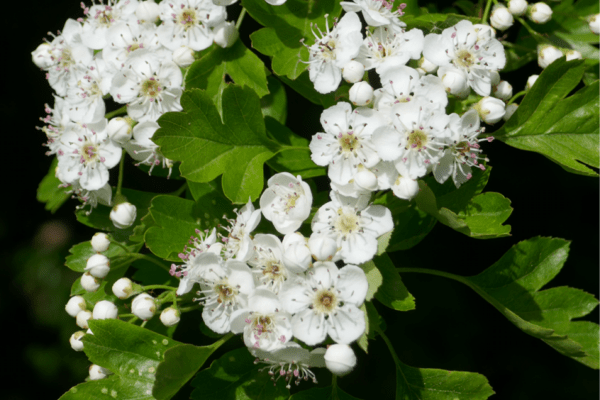
the orchards today
The middle reaches of the Clyde Valley between Lanark and Motherwell, winds its way through scenic countryside of rolling farmland, woodlands and small towns and villages. Orchards are a characteristic feature of this landscape, in spring producing a wave of blossom on the valley slopes and in the autumn, a rich crop of apples, plums and other fruit.
The sheltered slopes of the valley, with their well-drained soils and moderate rainfall, are particularly good for fruit growing. Their location, not far from some of Scotland’s major cities and towns, was also an important factor in their development, particularly during the period of industrial growth in the Central Belt.
status of the orchards
A study of the Clyde Valley orchards, commissioned by Scottish Natural Heritage in 2001 (IF-report), found over 70 orchards along the 10 miles of valley between Lanark and Wishaw. The estimated area of these orchards was thought to be around 64 hectares. Although this is a good number, it compares poorly with records of the same area in 1908 where approximately 307 hectares of commercial orchards were recorded.
A total of 53 varieties of fruit were identified within the 60 orchards that were recently surveyed, although not all types present were identified and there are likely to be undiscovered varieties.
The change in degree and type of management of the Clyde Valley orchards over the centuries has left us with a number of different kinds. Where they are managed, they are generally similar to the traditional model in that they are not densely planted, are dominated by older ‘standard’ trees, and are sometimes grazed by livestock. Some owners have, and do use chemicals but these days this tends to be minimal. We have neglected orchards, garden orchards, those managed to enhance wildlife, and a few with more ‘modern’ commercial methods of management.
The Flourish - Blossom in the clyde valley orchards
Many people in the Clyde Valley refer to the blossom which graces the various fruit trees of the orchards as “flourish”. As the Spring unfolds, different trees display their individual and beautiful versions of the flourish. As well as a natural precursor to the product of fruit almost all tree varieties there is also a symbolic or superstitious association.
Blackthorn
(Prunus spinoza)
Blackthorn is normally the first blossom. The cluster of flowers appear before the leaves. It has thorns on the branches and in the autumn produces blue/black sloes which are used to flavour gin.
It is thought that this is one of the trees which crosses the barrier between this world and that of the spirit or fairie. In Irish mythology it was believed to be inhabited by the Lunantisidhe (Moon fairies). The crown of thorns that Jesus was forced to wear is reputed to have been made from the Blackthorn.
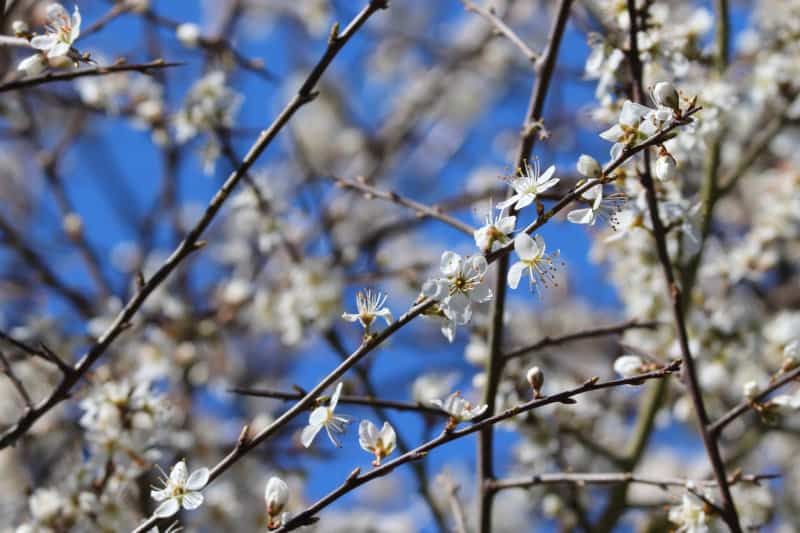
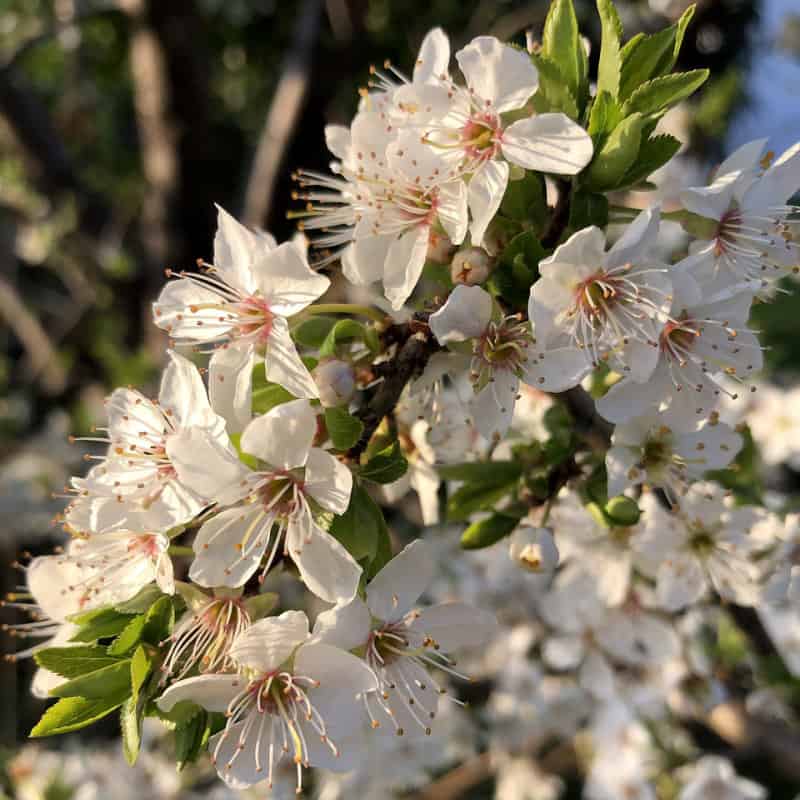
Damson
(Prunus domestica subsp. institia or sometimes Prunus institia)
Generally flowering in April Damsons have clusters of small white flowers. The name comes from the Middle English damascene or “plum of Damascus” and introduced to the UK by the Romans. The fruits are smaller, darker and harder than a plum. Although slightly more sour than plums they are still sweet and excellent for jams and flavouring spirit. Though trees they have been traditionally used in orchards as windbreaks or hedges.
Cherry
(Prunus avium)
Cherry Blossom tend to flower in April although it varies significantly. More decorative pink blossom trees grace many gardens but white blossom is also found in orchard specimens. Most famously Japan celebrates Sakura the cherry blossom season. Cherry blossoms are a symbolic flower of the Spring, a time of renewal, and the fleeting nature of life. Their life is very short. After their beauty peaks around two weeks, the blossoms start to fall.
During this time in Japan, people like to have cherry blossom parties with colleagues, friends, and family. They enjoy eating, drinking, and barbecuing underneath the cherry blossoms. They call this custom hanami. Hanami literally means “watching blossoms,” and the tradition can be traced back at least a thousand years.

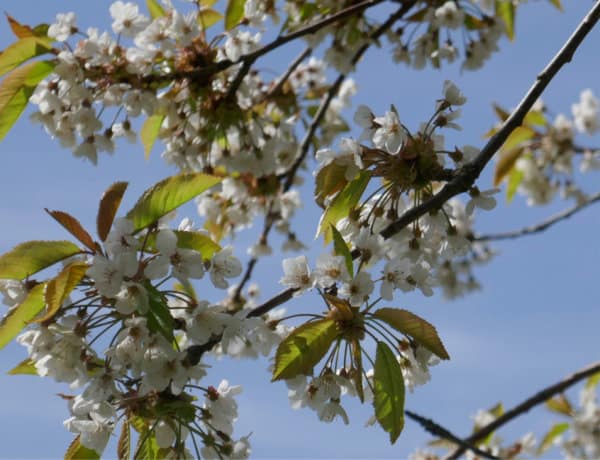
Gean
(Prunus avium)
The distinctive wild cherry is a fast growing deciduous tree native to Scotland, often found in mixed and beech woodlands throughout the country. It is thought that the name Gean shares its linguistic roots with guigne, a French word for cherry. Birds love these small sweet fruits; they will gobble them up even before they are fully ripe. So that is why the wild cherry is called Prunus avium literally meaning in Latin “of the birds”. This tree has a potential life span of over 200 years.

plum
(Prunus domestica)
In the Clyde Valley the variety Victoria Plum was the queen of the orchards. Historically in the valley this fruit was produced as a commercial crop. However a late or hard frost can devastate the development of the fruit. A delicious juicy fruit with orange flesh with a reddish or mottled skin – it can be used in jam making.
Since ancient times Plum trees, their fruit and delicate, fragrant flowers have been drenched in meaning and mystery. The seemingly humble Plum tree has symbolic meanings from cultures all over the world!
In Chinese philosophy, the Plum tree’s blossom is a symbol of winter ending and a herald of Spring. The tree’s pale pink blossoms are cherished because they bloom vibrantly and so bravely amidst the winter chill. They symbolise perseverance and hope, as well as, beauty thriving in adverse circumstances.
Japanese tradition holds that the Plum (or “ume”) is celebrated as a protective charm against evil, so the ume is traditionally planted in the northeast of the garden, the direction from which evil is believed to.

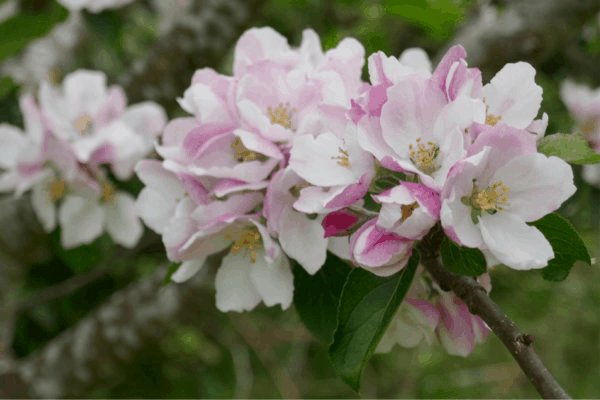
Apple blossom
(Malus domestica)
Apple blossom normally will appear in later April and/or early May and usually is white tinged with pink – although some cultivars are fully pink. They bloom on short shoots or in clusters at the tips of branches.
The apple became a symbol for knowledge, immortality, temptation, the fall of man and sin. The similarity of this word to Latin malum, meaning “evil”, may also have influenced the apple’s becoming interpreted as the biblical “forbidden fruit”.
crab apple
(Malus sylvestris)
A symbol of fertility and a forager’s delight. Crab apple trees are associated with love and marriage and its small, hard fruits make an exquisite, jewel-coloured jelly. Crab apples are excellent pollinators in orchards for Malus species.

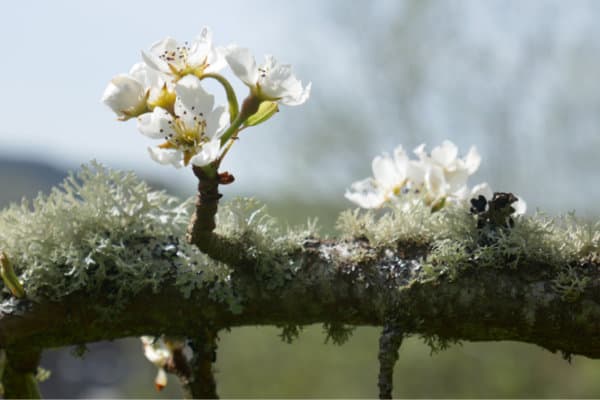
Pears
(Pyrus communis)
First introduced around AD 995, the diverse and delicious pear is a favourite with wildlife and people. Flowers are white throughout and appear in clusters up to 3cm across. In Victorian “Language of Flowers” Pear Blossom represented lasting friendship.
Hawthorn
(Crataegus monogyna)
This spiky tree has a variety of names hawthorn, quickthorn, thornapple, May-tree, whitehorn or hawberry.
The berries, known as Haws, have a variety of possible uses. Hawthorns provide food and shelter for many species of birds and mammals, and the flowers are important for many nectar-feeding insects while the haws are important for wildlife in Winter particularly thrushes and waxwings.
The Hawthorn has a distinct place in folklore and is associated with Beltane, the ancient Celtic festival celebrating Spring.
The Scots saying “Ne’er cast a cloot ti Mey’s oot” conveys a warning not to shed any cloots (clothes) before summer has fully arrived and the Mayflowers. Traditionally hawthorn berries are used to make jellies, wines and ketchup. Honeybees foraging on hawthorn blossoms bring a harvest of dark amber and nutty hawthorn honey.
